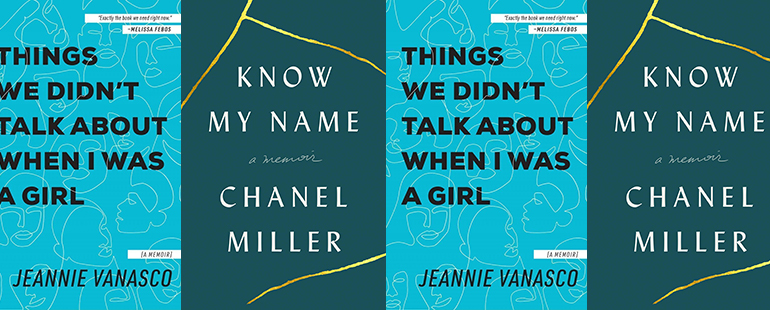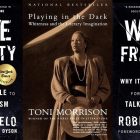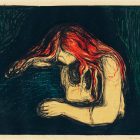Reading Know My Name and Things We Didn’t Talk About When I Was a Girl

Ten years ago, I pulled my best friend into a bathroom to tell her that something had happened to me. It was the day after. I was distraught, and my mouth fumbled for words, one I didn’t want to say. The word was so damning. It damned him, and it felt treacherous to damn him—particularly because we were friends. Mostly, though, I bit back the word because I didn’t want to damn myself to being disbelieved and questioned and humiliated.
I was raped a handful of days before I left for college, half a decade before Trump would make news for saying of women: “Grab ’em by the pussy”; five-and-a-half years before I marched, wearing a pussy hat, in the streets of Washington, D.C.; six years before Emily Doe made the news with her incredibly public trial against the man who raped her, Stanford student Brock Turner; six years before we watched a judge give Brock a slap-on-the-wrist sentence—six months in county jail that good behavior would reduce to three; and nine years before I learned that Emily Doe is Chanel Miller, a woman I went to college with, workshopped my writing with, and whose smile and throw-your-head-back laugh I can easily call to mind.
That day, the searing anger I’d felt about Brock Turner’s sentence came back to me. Back then, it was too hard for me to read Chanel’s victim impact statement; I already thought about my own rape most days—still do—flashes that burst through my memory while walking across a bridge with my dog, or while in my car on the way to yoga, or in my therapist’s office where I was still too afraid—even in that space—to say what my rapist did to me. Learning of Emily Doe’s identity, then, was a punch to the gut: I thought about how public Chanel’s trauma had been made; I thought about the woman I once knew who had been irrevocably altered by this trauma the moment it occurred and then again and again in a courtroom and by the media; I thought about how I’d had no idea she’d been assaulted, a feeling I’ve experienced before when friends have shared their assaults with me. And I thought about myself and the trauma buried inside me like a bone once broken that aches when the weather changes. I felt sick imagining what it would be like to have my own rape scrutinized so publicly.
I discovered Chanel’s identity through the New York Times announcement of the publication of her memoir, Know My Name, in which she describes the assault and the effects it has had on her life and on those close to her. Know My Name is also about what it’s like to be a woman and, ultimately, to be human. Within weeks of the publication of Chanel’s memoir, Jeannie Vanasco’s second memoir, Things We Didn’t Talk About When I Was a Girl, was published. In it, Vanasco examines her rape, by her high school friend, and all of the emotions and second guessing that came along with it. Even as they differ, the similarities between Chanel’s and Vanasco’s assaults are uncanny, as are their overlaps with mine and, likely, any survivor’s. “There’s nothing original about my story, and that’s the point,” writes Vanasco. “There have always been Marks, and I doubt they’ll stop existing. Although these Marks rarely apologize for their behavior.” Sexual assault is pervasive, an experience shared largely by women, and while some perpetrators are remorseful, like Vanasco’s, others, like Brock Turner, will go to great lengths to deny their actions even in the face of overwhelming evidence.
One of the primary aspects of the assault that Vanasco wrestles with is the feeling of betrayal, the same feeling I am consumed by. How could my friend be the same person who viewed my limp body as consent? When Mark assaulted her, Vanasco’s father had just died. They were at a small party, and she got drunk for the first time. Then, Mark carried her into his basement bedroom. “For years, I tried to forget that night,” Vanasco says. “But the more I tried to forget, the more I remembered. I can still see Mark standing above me in the dark basement, slowly undressing me.” He masturbated over her as she cried. “I can still hear his lie: It’s just a dream,” she continues. “The clichéd ending writers are told to avoid.” When a writer uses that line, a reader feels cheated by a writer wiping away a story instead of fully realizing it. When a rapist uses that line, he wants to dupe his victim, casting their assault as a fiction that should be discarded.
Awful though this experience is for Vanasco, she is unable to shake the memory of her friend and their friendship. “Every time I think about him, I feel pissed off and sad,” she muses. “I understand now why nostalgia, for hundreds of years, was considered a chronic mental illness.” Like me, she questions how she could so foolishly trust a friend, but also how a friend could do this to her. Vanasco constructs her memoir around interviewing Mark about the assault. She lays out the experience for her reader through her internal dialogue about the decision to interview Mark, initial communication with him, and her transcription and examination of the interviews. Throughout, she also includes conversations she had about the project with her partner and friends. “[Mark] better feel so terrible that he admits, I preyed on your vulnerability,” Vanasco asserts. “Otherwise, this project, founded on my belief that Mark was my friend, falls apart.” She is preoccupied by this detail; it is essential to her exploration and understanding of her assault. “I want to be honest here,” Vanasco says, “because I doubt I’m the only woman sexually assaulted by a friend and confused about her feelings.”
Chanel’s assault diverges from Vanasco’s here: Chanel was raped by a stranger who told police he wouldn’t be able to pick her out of a crowd. Chanel was just as faceless in the media, while Brock was portrayed as a Stanford athlete who’d swum in the London Olympic trials. “He was a kid, not a criminal. Accomplished, not dangerous. He was the one who lost everything,” Chanel writes. “I was just the nobody it happened to.” She doesn’t spend time weighing her significance to Brock, whose narrative established that she was worthless in comparison to him; he’d hired a high-powered lawyer to prove that what he’d done—finger an unconscious woman behind a dumpster—was not assault. “My pain was never more valuable than his potential,” Chanel notes after hearing the judge’s sentencing. Vanasco also considers her position in relationship to her rapist’s, a high school peer. They had disparate high school experiences: he was apathetic, whereas she put in hours of effort. In their conversations after the rape, Mark subtly tried to equalize their experience, but the rape makes being equal impossible. One’s potential, or lack of it, has no bearing on the crime.
Both women wrestle with the role alcohol played in their assaults—a common anxiety many survivors, including myself, have about their experiences. “Another question now bothers me: Why did I emphasize that this was the first time I was drunk?” Vanasco asks. “Is it because my drunkenness disqualifies me from being The Good Victim?” Chanel grapples with a similar desire to be viewed as human, frustrated with the sexist cultural insistence on dismissing, denigrating even, a woman for being drunk—inexcusable behavior for her but not for him. She was found unconscious and didn’t regain consciousness until she was on a stretcher in a hospital, unaware of what had happened to her. She learned later—in pieces, from the news—that she’d been digitally penetrated, the meaning of which she subsequently learned from Google. She learned what had happened to her via the pine needles littering her hair and the crosshatch she glimpsed on her butt cheek when she peaked over her shoulder during her examination. She learned what happened from pictures of the crime scene she saw during the trial and later glimpsed while pouring through files as she wrote Know My Name. She never doubted, though, that she hadn’t consented. “No is the beginning and end of this story,” Chanel asserts. “You looked dead,” Chanel’s dad said to her after leaving the court room. “Like someone tried to toss a body into the dumpster and missed.”
Chanel’s memoir is about her rape, but it’s also about what it means to move through this world in a woman’s body, the harassment women experience on a daily basis, and how it’s near impossible for a woman to walk down the street without being cat-called, whistled at, or otherwise violated. What has happened to Chanel’s body, to Vanasco’s body, and to mine connects us with millions of women globally and across time. “Victims are all around you,” Chanel writes, describing the sort of everyday encounters you might have with a victim: a teacher, a fellow subway passenger, a barista. There are the women who came forward in the trials of Bill Cosby and Larry Nassar, and the women of the #MeToo movement. In a matter of days, over fifteen million people viewed Chanel’s victim impact statement and shared in comments, cards, and emails how much it meant to them. “Because Emily Doe used the word rape, I now feel comfortable using it too,” Vanasco says. “And if I can use the word rape to describe Mark’s actions, maybe some readers of this book—who also have been raped in the same way—won’t diminish what happened to them.” This word binds us, gives us the strength to name our experience no matter what exactly someone did to our body without our consent.
Found with her left breast exposed and her underwear removed and discarded away from her body, Chanel knew that she had not consented—could not have consented—but still, the district attorney explained, it was up for debate. Because Chanel was drunk, and because Chanel had no memory of the event, she became Brock’s only way out. “[H]er reasoning hit me with horrifying clarity,” Chanel writes: “It was like watching wolves being clipped off their leashes while someone whispered in your ear that meat has been sewn into your pockets.” Here, Chanel demonstrates a hallmark of her memoir: the ability to weave beautiful language into her narrative, searing into the reader’s mind just how horrifying her experience was.
Even as both women describe the horrors of what happened to them, they work to humanize their rapists, underscoring how essential it is to their stories that the reader understand that these men could be monsters and “good” people at the same time. Vanasco opens her memoir with a favorite memory of her and Mark—a memory establishing their friendship and how much they, seemingly, mattered to each other. While interviewing Mark and examining the interviews, she is nostalgic for their friendship. “I want readers to like Mark, to see why I trust Mark, to think, Of course Jeannie wouldn’t have expected him to assault her. That way his betrayal will seem as unthinkable and unexplainable as it seemed to me then.” I’ve felt the same mixture of nostalgia and shock and even anger. I miss my friend, and I struggle to reconcile him with the person who dismantled our friendship with a violent betrayal that not only altered how I viewed our friendship but also how I viewed myself and the world, particularly men and my relationship to them.
Yet this nuance that Chanel and Vanasco build in their books is lost in a legal setting. In the courtroom, Chanel’s character was scrutinized, and the defense worked “to erase [her] specific experience [and] abstract [her] into stereotypes of partying and blackouts.” Brock, on the other hand, was described as possessing the sort of wholesomeness expected of someone with so much potential, and this characterization was built through witnesses, character letters, and online posts. Ultimately, though, the jury was forced to decide whether he was “wholesome or monstrous”—there was room for no gray area. “I never questioned that any of what they said about him was true,” Chanel states. “The friendly guy who helps you move and assists senior citizens in the pool is the same guy who assaulted me. One person can be capable of both. Society often fails to wrap its head around the fact that these truths often coexist, they are not mutually exclusive. Bad qualities can hide inside a good person. That’s the terrifying part.” My friend was a person who made me laugh, who supported my weight when he belayed me in rock climbing, but he was also the person who saw how incapacitated I was and did what he did to me anyway.
Reading Chanel and Vanasco’s memoirs, I had to take breaks—their stories felt like mine, and I relived my rape through them reliving theirs and the way in which they did so. In places, both writers examine their assaults in a measured way, splicing in their research, but in other moments, they reveal how the horror of their assault can submerge them in the past. “Trauma provides a special way of moving through time,” Chanel writes, “years fall away in an instant, we can summon terrorizing feelings as if they are happening in the present.”
I remember a picture taken of me the day after my assault. I’m in an oversized pastel blue linen shirt and jean shorts, barefoot, leaning casually against a grassy slope among my friends. I’m smiling. Looking at the picture, you can’t see all my confusion and the sudden awareness that the world was not what I once thought. As the days passed while Chanel waited for the DA to call and tell her it was time for her to testify, Chanel posted a photo online of a burrito. “I received thirty-two likes,” she noted. “It was a joke with myself, playing tricks on the world. People believed I was enjoying my afternoon, when in reality I was about to face my rapist. How creepy it was that we could conceal these stories. How easy it was to pretend. The slivers we show, the mountains we hide.” I think I may have seen this post. In the years after college, I saw Chanel looking normal: the doodles she drew, pictures of her new life in Philadelphia, her smiling. She looked like any recent college grad. That picture of me on the grassy hill, a trick I played on myself and the world.
Rape engenders a complicated horror, whether we are raped by a friend or a stranger, because we are forced to come to terms with a new version of our self and our world. “I stopped when I saw the words Rape Victim in bold at the top of one sheet,” Chanel says about the paperwork she signed the morning after Brock assaulted her. “If I refused to sign, could I remain my regular self?” But that regular self is gone for good once someone is assaulted. “Assault buries the self,” Chanel writes. “We lose sight of how and when we are allowed to occupy space. We are made to doubt our abilities, disparaged when we speak.” We become selves that evolve in the wake of our assaults—not wholly monstrous or regular—selves possessing multiple facets, relearning how to occupy space.
This piece was originally published on December 4, 2019.



